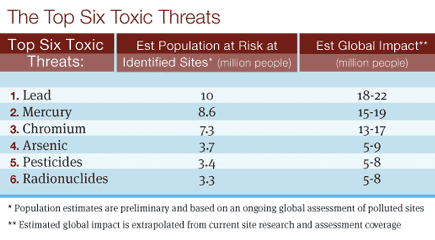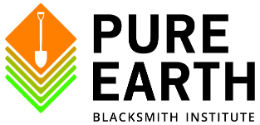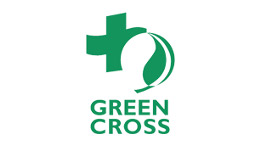Press Release
Top Toxic Threats Revealed in New Report
A New Report Titled “World’s Worst Pollution Problems” Identifies Six Toxic Pollutants That Pose Health Risks to Tens of Millions of People
New York City, November 3, 2010 – A new report released today by two international environmental groups—New York-based Blacksmith Institute and Green Cross Switzerland—highlights the top six toxic threats to global health. The organizations estimate that these pollutants impact the health of tens of millions of people, primarily children, and that toxic pollution as a whole could cause health risks for more than one hundred million people globally. 
The report ranks the pollutants according to the number of people estimated to be at risk from each toxin and describes their physical nature, industries that typically cause their release, common human exposure pathways, and known health effects. The full report is available at http://www.worstpolluted.org.
“The health of roughly 100 million people is at risk from pollution in developing countries,” says Richard Fuller, President of Blacksmith Institute. “The six pollutants in this report come up again and again at the sites we evaluate.”
The data analyzed in the report are based on over 1,000 risk assessments conducted by Blacksmith Institute investigators at polluted sites over the past two years. This work is funded in part by Green Cross Switzerland and is carried out in over 40 countries, by more than 150 field investigators.
The 2010 report focuses on specific pollutants, rather than polluted sites or sources of contamination, as was the focus of previous reports by Blacksmith Institute and Green Cross Switzerland. This approach captures the breadth of the problem, as pollutants are global in scope and come from a range of sources. Lead, for example, affects communities in nearly every country and comes from a variety of sources—from large-scale smelters in Peru, to small-scale metal recyclers in Senegal.
The health impacts from the Top Six Toxic Threats include physical and mental disabilities, organ dysfunction, neurological disorders, developmental problems for unborn fetuses and children, cancers, and in some cases, death. These pollutants can weaken the immune system, rendering a person more susceptible to disease. An initial exposure to toxic pollution can be the undocumented cause of later illnesses, such as respiratory infections, tuberculosis, gastrointestinal disorders, and maternal health problems.
Blacksmith Institute uses a risk assessment method based on the US EPA Superfund protocol to assess sites. This protocol is simplified for the purpose of rapid and affordable field assessments. The method was developed by a team of international environment and health experts—including researchers from Johns Hopkins University, Bloomberg School of Public Health, Mt. Sinai Medical Center, Emory University and City University of New York—serving on Blacksmith Institute’s Technical Advisory Board. Specialists from Green Cross Switzerland also participated in this evaluation. The assessment method characterizes three general criteria: pollutant type and amount, pathway to humans, and population at risk.
Success Stories
The 2010 report also includes examples of cleanup success stories. The project summaries describe the strategies that organizations like Blacksmith Institute and Green Cross Switzerland employ to mitigate the health impacts from toxic releases. Past cleanup projects designed by the groups range from the very low tech—using worms or molasses to neutralize pollution—to more technical engineering projects involving soil removal and groundwater remediation.
“Fortunately, these pollution problems can be dealt with affordably and effectively,” says Fuller. “In many cases there already exist replicable solutions that have shown success.”
About Blacksmith Institute
Blacksmith Institute is an international not-for-profit organization dedicated to solving life-threatening pollution issues in low- and middle-income countries. A global leader in this field, Blacksmith identifies and cleans up the world’s worst polluted places, where human health, especially that of women and children, is most at risk. Based in New York, Blacksmith works cooperatively in partnerships that include governments, the international community, NGOs and local agencies to design and implement innovative, low-cost solutions to save lives. Since 1999, Blacksmith has completed more than 50 projects. Blacksmith is currently engaged in approximately 40 projects in 20 countries.
About Green Cross Switzerland
Green Cross Switzerland facilitates overcoming consequential damages caused by industrial and military disasters and the clean-up of contaminated sites from the period of the Cold War. Central issues are the improvement of the living quality of people affected by chemical, radioactive and other types of contamination, as well as the promotion of a sustainable development in the spirit of cooperation instead of confrontation. This includes the involvement of all stakeholder groups affected by a problem.
******************************************************************************
To view the full report, please visit www.worstpolluted.org
For more information on Blacksmith Institute, please visit www.blacksmithinstitute.org, or contact Blacksmith at , +1.212.647.8330.
For more information on Green Cross Switzerland, please visit www.greencross.ch, or contact Green Cross Switzerland at , +41 (0)43.499.1313.





